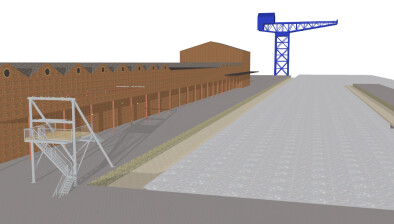And finally…shell shock design for 2000 year-old Roman theatre

A 2000 year-old Roman amphitheatre in the northern Italian city of Verona could be in for a long-overdue revamp after a German architecture firm won a design competition with its novel idea for a scallop shell-like retractable roof.
Achitects von Gerkan, Marg and Partners (GMP), together with engineers Schlaich Bergermann Partner (SBP), won the international ideas competition with its concept for the Arena di Verona.
The arena, which was built in 30 AD under Emperor Tiberius for 30,000 spectators, is one of the largest and best preserved Roman amphitheatres.
Having fallen into ruin after the fall of the Roman Empire and reopened during the Renaissance, today it only allows for audiences of 15,000 when it is used for the performance of operas and concerts.
Now the creative approach offered by the German consortium could see it again given a new lease of life.
The competition brief was to design a retractable and reversible roof structure which – on the one hand – makes it possible to use the arena during bad weather and protects it against adverse environmental effects, and – on the other hand – respects the historic monument as best possible and interferes as little as possible with the structure and appearance of the amphitheatre.
GMP’s winning design includes a compression ring which is clearly raised above the arena and holds the retractable membrane construction.
The new structure covers the entire area of the amphitheatre in the shape of an ellipse and creates space for additional lighting and state-of-the-art stage technology.
An intelligent mechanism, involving a fan-shaped movable cable network and the roofing membrane, protects the entire arena against bad weather, but can also be fully retracted into the compression ring when the weather is more favourable.
The shell roof is closed in a two-step process in which the cables are moved out from their home position in the compression ring and then the membrane is extended along these cables.

The designers explained: “This configuration of a retraction mechanism is completely unique and has never been built before. Nevertheless, there are many elements of tried-and-tested retraction mechanisms in completed projects, such as the stadium in Frankfurt and the national stadiums in Warsaw and Bucharest, which can be re-applied and developed in this new configuration for Verona.
“Winches are used to move the cables from their parking positions to their extended positions along the oval compression ring. Once they are firmly attached in their final position, the cables are hydraulically pre-tensioned in the mechanical part of the parking area. Now the membrane parked in that area can be extended outwards in the shape of a star using radially acting cable winches. A few inches before the end position, hydraulic tensioners engage with the front moving trolleys and apply the required pre-tension to the membrane.”
The firm added: “From a bird’s eye view, the closed roof appears like a protective scallop shell that gently covers the historic building.”
The jointly developed design was the winning entry of over 80 competing submissions, and continues the many years of cooperation between the two practices.
Following the Borgo Trento hospital and the new trade exhibition halls, this could become the architects’ third project in Verona.














